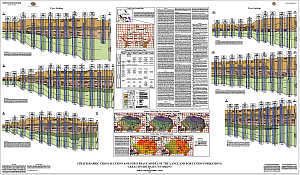NEWS RELEASE: WSGS Releases Geologic Study on the Great Divide Basin
Wyoming State Geological Survey sent this bulletin at 07/29/2015 09:00 AM MDT |
|
Having trouble viewing this email? View it as a Web page. |
July 29, 2015
******FOR IMMEDIATE RELEASE******
Media Contact:
Chamois Andersen
307-766-2286 x231
chamois.andersen@wyo.gov

WSGS Releases Geologic Study on the Great Divide Basin
New research on the Lance and Fort Union formations has allowed geologists to better define the extent of the coal-bearing strata and potential natural gas reservoir rock in the Great Divide Basin of Wyoming, according to a recent study by the Wyoming State Geological Survey (WSGS).
“These correlations should help guide future assessments of coal in these formations, as well as the availability of natural gas and coalbed natural gas in the Great Divide Basin,” says Ranie Lynds, oil and gas geologist at the WSGS.
The subsurface correlations were based on well logs from oil, gas, and coal exploration efforts throughout the Great Divide Basin, a sub-basin of the Greater Green River Basin. The findings are presented in WSGS Open File Report 15-3, Stratigraphic Cross Sections and Subsurface Model of the Lance and Fort Union Formations, Great Divide Basin, Wyoming, by Ranie M. Lynds and Christopher J. Carroll. This report is available in a large poster format for $25 via the agency website or as a free pdf download.
For the study, Lynds and Carroll created a database of more than 4,000 records of exploration wells with data provided by the Wyoming Oil and Gas Conservation Commission and the U.S. Geological Survey.
“The goal of this project was to gain a better understanding of the clastic depositional setting during the Late Cretaceous through Paleocene time interval,” says Lynds. “These results should provide the basic framework for future studies of coal and natural gas potential in the area, as well as help to better understand the geologic history of the Great Divide Basin.”
This WSGS Open File Report (large poster format) includes a series of six cross sections, three structure contour maps, and two isochore (vertical thickness) maps. It also includes a description of the geologic history and stratigraphy as well as references. The cross sections indicate two main coal intervals within the Fort Union Formation. The lower coal-bearing interval reaches a maximum thickness of approximately 2,500 feet (60 feet of net coal thickness) in the northeast portions of the Great Divide Basin, and thins to less than 600 feet in the west (23 feet net coal), near Point of Rocks. The upper coal-bearing interval is nearly 1,000 feet thick (37 feet net coal) in the central part of the basin and is entirely absent along the western margin. Most of the natural gas shows in the region are from the lower part of the Lance Formation, which generally thickens to the north and east.
The Lance and Fort Union formations are important natural gas reservoirs in Wyoming. Nearly 670 billion cubic feet (Bcf) of natural gas was produced from the Lance Formation in the Greater Green River Basin in 2014, and the Fort Union Formation yielded more than 13 Bcf of natural gas. According to the Wyoming Oil and Gas Conservation Commission, the Jonah and Pinedale fields combined produced more than 196 Bcf of gas from the Lance Formation in 2014.
The Great Divide Basin is also home to the largest coal mines in Wyoming outside of the Powder River Basin and includes the state’s only underground mine. Coal from the Fort Union Formation is a known resource along the margins of the basin, and has historically been the target of mining operations, coalbed natural gas extraction, underground coal gasification, and the Jim Bridger coal-fired power plant.
This WSGS study was partially funded by a National Coal Resources Data System, through a cooperating agency grant from the U.S. Geological Survey.
###
You are subscribed to All News Releases for Wyoming State Geological Survey. This information has recently been updated, and is now available.

